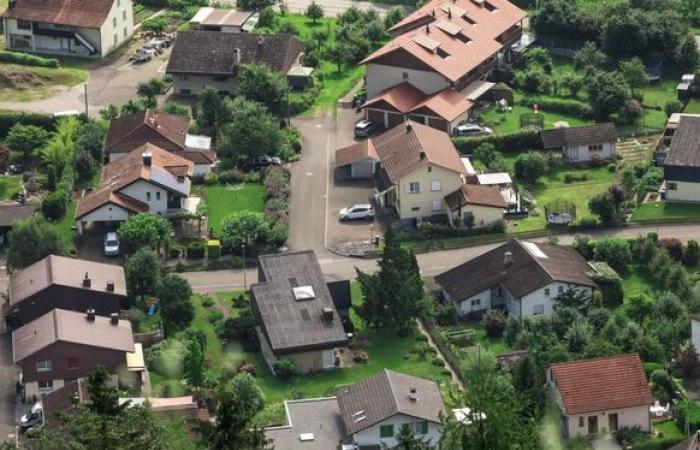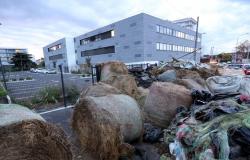We are at the dawn of a supercycle in real estate (illustrative image).Image: watson
Neither Covid-19, nor inflation, nor high interest rates have succeeded in stopping the real estate boom. A new problem is emerging: gentrification.
Niklaus Vontobel / ch media
The reversal in interest rates is already over. And as the major bank UBS writes, we are even returning to a world of low rates. Inflation is falling around the world; the central banks of the United States, Switzerland and the euro zone have all lowered their key rates. This clearly shows that even this crisis could not stop the real estate boom.
Although residential property prices have fallen in some countries, notably in Germany where the decline was historic, the feared horror scenario did not occur. Overall, prices have fallen only slightly in industrialized countriesdespite the Covid-19 crisis, inflation and high interest rates. And today, they are already skyrocketing.
Prices could continue to rise for a long time, even though they have now been doing so for decades – and perhaps even faster than before. The British magazine The Economist recently wrote that the housing boom risks becoming “even more scandalous.” Prices would now be driven by a “supercycle which is only just beginning”.
Explosion of prices since 1960
This “supercycle” describes the evolution of residential property prices around the world over the past 70 years. Before this there was no upward trendas shown by a study of fourteen industrialized countries. In the early 1960s, real prices were still about the same as in 1870. Nearly a century had passed and prices were still about the same.
Everything is already built: escaping to the countryside has become more difficult.Image: Getty
Then prices started to rise and residential real estate became inexorably more expensive. Five decades later, in the 2010s, real estate cost three times as much in real terms. And even after that, nothing could stop their rise in prices. Nor the financial crisis of 2007 to 2009; nor the Covid crisis, as we can now see. Today, prices in 26 countries are on average 135% higher than almost a quarter of a century ago. Switzerland is doing a little better: prices are “only” 94% higher.
Will this supercycle really last for decades? The fact that it is fueled by powerful trends that have fundamentally changed not only real estate markets, but also our daily lives, speaks in favor of this hypothesis.
Transportation revolution
An early trend was the end of the transportation revolution after 1970. It had once made cars and trains affordable and caused their prices to fall, thereby causing the so-called “death of distance.”
Lower transportation prices have helped the industry. It no longer depended on the proximity of ports or train stations, around which many cities had been built. Companies could now locate their factories wherever they wanted: along highways, rail networks, or even abroad. Workers followed, building their homes in the countryside and commuting to work. The result was an exodus from the cities.
But in the countryside there was more space available to build apartments. This had enormous consequences on the real estate market. As Edward Glaeser, an economics professor at Harvard University, explains, this kept prices down for decades.
Then the transportation revolution ended, and transportation costs no longer saw such dramatic declines. The new building plots in the open countryside were rarefied throughout the world. There were too few to keep pace with demand, driven by population and income growth. Real estate prices started to increase inexorably.
Renaissance of cities
After 1950, trends began to attract people to cities. Banks, advisors, insurers, accountants and lawyers were gaining importance. In cities, they were closer to customers, universities or competitors. Glaeser writes, for example, that cities are better for knowledge transfer. And this is not insignificant: all it takes is a little more information, and a trader pockets millions in a few minutes.
These key urban areas were followed by others, such as hotels, retail and restaurants. American cities like New York and San Francisco saw dramatic growth in these sectors in the 1980s, Glaeser writes. In Europe, cities like London and Frankfurt have experienced similar success.
All of this has led to a renaissance of cities – but, according to Glaeser, as is often the case when cities triumph, there are many losers. Urban housing is highly sought after and is becoming more and more expensive. Anger is growing over the gentrification of once-affordable neighborhoods.
Unhindered construction, a solution?
The Economist argues that the solution is clear: if demand and prices increase, supply must follow – more should be built. According to economist Glaeser, this would help a lot:
“The best way to promote the financial accessibility of housing is to remove obstacles to new construction”
This is what cities once did. In early 1920s New York, demand for urban housing had also exploded, but prices remained affordable as up to 100,000 new homes were built each year.
This works even if new buildings are more expensive to buy or rent than older ones, especially if they are built in desirable areas. According to Glaeser, they have a process in place that ensures that expensive new buildings also benefit low-income people, a filtering process.
New homes in trendy neighborhoods are occupied by high-income earners; their old houses, therefore less expensive, located in less trendy neighborhoods, become accessible to average employees; and their even older, even cheaper houses, located in even less fashionable neighborhoods, become accessible to low-income people.
This filtering process stopped sometime after the 1970s. According to economist Glaeser, resistance to new construction in cities had become too intense: protests from local residents had increased and regulations had become too strict. Moreover, the latter conducted a study whose results support this hypothesis. This shows that, in large cities, areas with more regulations have less construction activity and higher prices; Lightly regulated areas experience greater construction activity and lower prices.
La gentrification
The filtering process has been replaced by gentrification: high-income people no longer move to new, expensive neighborhoods, but to affordable neighborhoods, where they raise prices and change businesses and restaurants. Glaeser sums it up this way:
“Lack of new construction leads to conflicts over the character of residential neighborhoods”
The end of the transportation revolution and the rebirth of cities helped keep the supercycle going through all crises. Today, boom could 'become even more outrageous' as other trends fuel real estate demand.
Thanks to falling interest rates, mortgages are cheaper again and more people can afford to buy a home. At the same time, the lack of investment is even greater, because federal or corporate bonds offer lower yields. Pension funds and insurance companies are paying more for real estate again.
Since the Covid-19 crisis, immigration to Western countries is also higher than before. According to The Economistthe foreign-born population in Western industrialized countries is growing by 4% each year – a record, in a “new wave of mass migration”. The article points out that politicians from Canada to Germany are taking tough action against this. Still, they would likely accept more immigrants than in the past – they ultimately need them to support their aging population.
The supercycle could therefore only really begin now. According to Glaeser, the only thing that could stop it is for cities to relearn how to do what they once knew how to do: build enough.
Translated and adapted from German by Léa Krejci
International news, day and night, is here:
The Polly Pocket house exists and you can spend the night there
Video: watson







